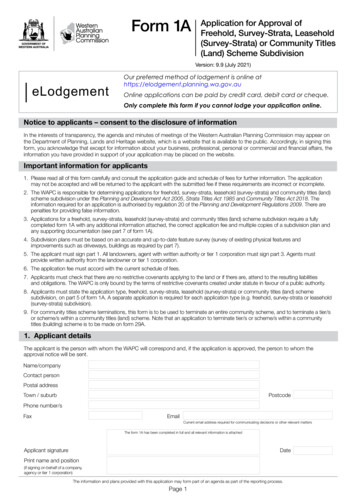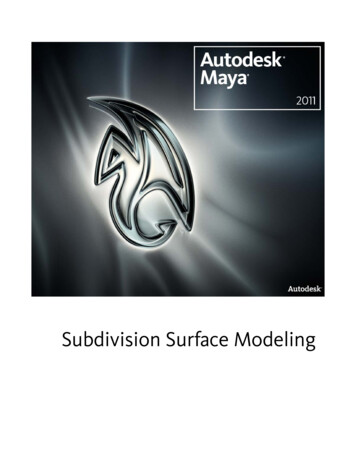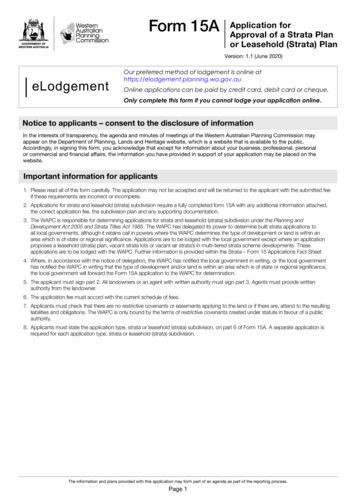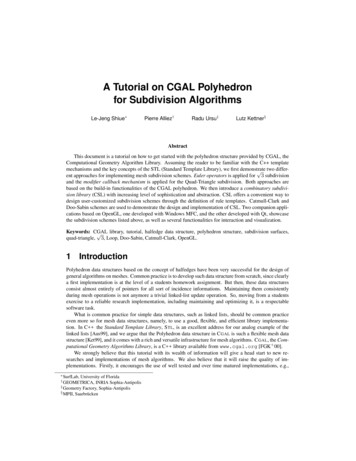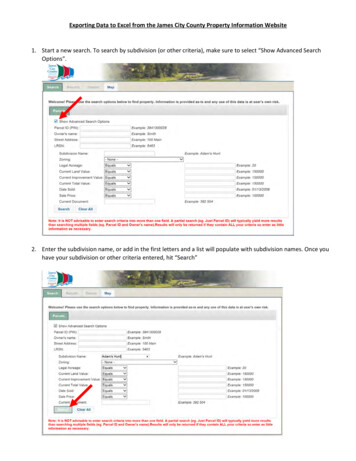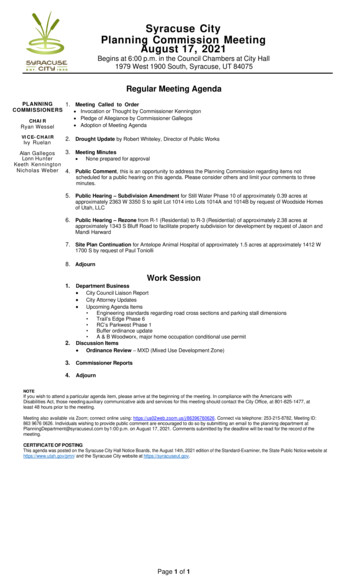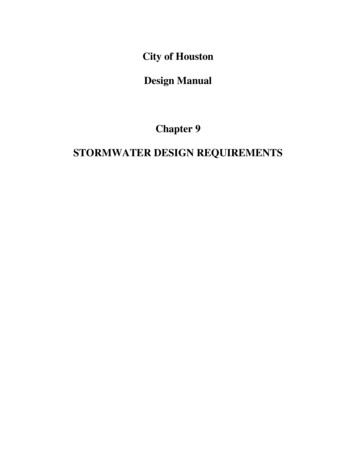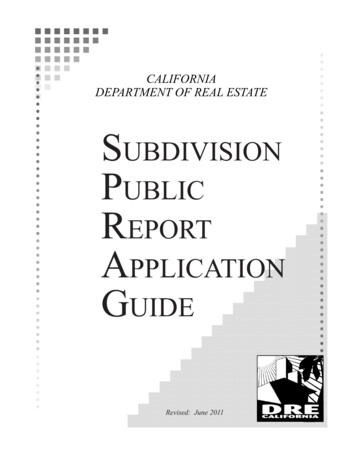
Transcription
CALIFORNIADEPARTMENT OF REAL ed: June 2011
PREFACEThis Guide has been developed for use by subdividers and agents (title companies, attorneys, etc.) who prepareNotices of Intention for subdivision public reports. Its purpose is to provide instructions and explanations of whatis required to properly comply with Notice of Intention requirements, thereby streamlining procedures for boththe applicant and the Department of Real Estate.This Guide is not intended to serve as a complete primer or reference work. It presupposes some familiarity withSubdivision Map Act requirements, Subdivided Lands Law, and related matters.SUBDIVIDERS WHO HAVE LITTLE EXPERIENCE IN APPLYING FOR SUBDIVISION PUBLICREPORTS ARE ENCOURAGED TO USE A QUALIFIED AGENT TO ASSIST IN PREPARING THENOTICE OF INTENTION.The first thing to do (after thoroughly reading this guide) is to obtain the necessary forms. Which forms you willneed depends on the type of project you are developing. Below is a list of subdivision types and the correspondingform packets. Department of Real Estate forms are referenced by “RE number” throughout SPRAG; completetitles are listed in Section XVII.If the project for which a Notice of Intention is being submitted has unusual or noteworthy aspects, processing ofthe submittal can be considerably simplified, and processing time thus shortened, if a cover letter is includedwhich describes the offering and highlights the unusual or noteworthy aspects thereof.Project/Filing TypeApplicationsStandard .Standard Application Package (RE 628 et al)Condominium, Planned Development,Community Apartment .Common Interest Package (RE 624 et al)Preliminary Public Report .RE 603 PackageAmendments/Renewals/Interims.RE 635 PackageYour understanding of this Guide will be increased if you have the pertinent forms ready for your reference.Individual forms may be ordered by using RE 695C; most forms are also available through DRE’s Web sitewww.dre.ca.gov , by clicking on the Subdivisions tab.This Guide is available free of charge on our Web site, www.dre.ca.gov, by clicking on the Publications tab. UseRE 350 to order a hard copy of the SPRAG. Updates to this Guide will be issued when necessary. This Guide isnot pertinent to, or correlated with, stock cooperative or time-share application packages.NOTE: THE GUIDE IS NOT COPYRIGHTED. YOU MAY REPRODUCE IT IF YOU WISH.
TABLE OF CONTENTSSection I - General Information.1A. Introduction .1B. Affirmative Standards.1C. Disclosure .1Section II - The Public Report Issuance Process .3Section III - Types of Public Reports .5A.B.C.D.E.F.G.Final Public Report.5Amended Public Report .5Renewal of Public Report .5Conditional Public Report .5Preliminary Public Report .5Overall Preliminary Public Report .5Interim Public Report .6Section IV - Who Must Apply .7A.B.C.D.Preliminary or Final Public Report .7Amended or Renewed Public Report.7HUD/OCRA.7Exempt Subdivisions.8Section V - Methods of Filing.10A.B.C.D.E.F.Minimum Filing Package (MFP).10Substantially Complete Application (SCA).10Preliminary Public Report .10Conditional Public Report .10Master File for Phased/Multiple Map Filings (Common interest only).12Overall Preliminary Public Reports .13Section VI - How to Apply .15A.B.C.D.Final Public Report.15Conditional Public Report .19Preliminary Public Report .19Amendments/Renewals/Conditionals/Interim Public Report.21Section VII - Master Management Documents .29A.B.C.D.How to Apply.29Classification of MMDs .29When to Update .29How to Use Approved MMDs.30Section VIII - Where to File Your Application.31Section IX - How To Facilitate Public Report Issuance .32A.B.C.D.Use the Latest Forms.32Get Expert Help .32Respond to Deficiency Notices Quickly and Completely .32Budget Review.32
E.F.G.H.I.J.K.Common Errors To Avoid. 32Reference the DRE File Number and Deputy . 33Designate a Single Responsible Party . 33Master Geographic Letters (MGLs). 33Requests for Expedited Reviews of Subdivision Filings . 34Subdivision Industry Bulletin . 34Real Estate Law Book. 34Section X - Issuance and Use of Public Report . 35A.C.D.E.F.Reproduction of the Public Report . 35Receipt for Public Report . 35Sale after Repossession by the Subdivider . 35Advertising . 36Posting the Public Report. 36Section XI - Insulation Disclosure Required by the Federal Trade Commission (FTC) . 38Section XII - Geologic Hazard Risk Special Note . 39Section XIII - Guidelines for Gift Programs and Creative Financing Plans . 40A.B.C.D.E.F.G.H.I.Gift Programs Used as Sales Inducements . 40Creative Financing Plans/Fact Sheets . 40All-Inclusive Trust Deeds . 41Negative Amortization Programs Coupled with Balloon Payments. 41Interest Subsidy Programs (Buydowns). 41Lease-Options. 42Equity Sharing or Shared Appreciation Mortgage . 42Sale by Real Property Sales Contracts . 42Ordinary Deed of Trust Taken Back by Subdivider/Seller. 42Section XIV - Subdivider’s Obligation to Pay Assessments —Record Maintenance . 43Section XV - Item Analysis. 44Section XVI - Glossary of Subdivision Terms . 120Section XVII - SPRAG Referenced RE Forms Index . 126Figures A–GABCDEFGProcessing Time Mandate .4Phased/Multiple Map.14Notice of Intention — Parts II & III.26Public Report Header.26Duplicate Budget Package File Layout .27Budget Review Request (RE 681) .28Sample Public Report Receipt .36
Section IGENERAL INFORMATIONA. IntroductionThe DRE has a legal mandate via the Subdivided Lands Law to regulate subdivision offerings. The purpose ofthe law is to protect the consumer from misrepresentation, deceit, and fraud in the public sale or lease ofsubdivisions.The means by which this is accomplished is the subdivision public report process. Subdivisions which fallunder DRE jurisdiction may not be offered for sale or lease until a conditional or final public report isobtained. Public reports are issued only if the proposed subdivision meets the requirements specified in theSubdivided Lands Law. These requirements, known as affirmative standards, are further defined by theRegulations of the Real Estate Commissioner, Subdivision Map Act and Business and Professions Code.The public report has a second function besides ensuring compliance with affirmative standards. The publicreport discloses significant consumer information about the particular subdivision for which it is issued.All prospective purchasers must be given a copy of the public report and must be given a chance to read itbefore any binding contract is signed. The disclosure function of the public report is no less important thanthe affirmative standard function because it can alert consumers to any negative aspects of a particularoffering. There is flexibility as to what can be disclosed, whereas the affirmative standards are statutory.B. Affirmative StandardsAffirmative standards deal with two major aspects of the proposed subdivision offerings: suitability forintended use and fair dealing.Suitability for intended use – The Subdivided Lands Law specifies that a public report will be denied if theoffering is unsuitable in any respect for the use proposed by the subdivider.The suitability test is, of course, paramount in residential offerings. The applicant must at least show thatthere is vehicular access, available water for domestic use and sewage disposal. If suitability cannot bedemonstrated, the offering will be treated as raw land, which will prohibit the owner from making claims toany particular use. (See application questions 11, 14 and 19.)Fair dealing regarding the sale or lease of the offering – The second major area of protection underaffirmative standards is assuring that the consumer will get what is bargained for. That is, the deposit moneywill be secure, the off-site improvements described by the subdivider (roads, sewers, etc.) will be completedand upon consummation of the transaction, clear title will be conveyed. Plus, other important aspects of thesale or lease will be assured.C. DisclosureBy law, certain information must be disclosed in the public report. DRE guidelines are specific on certainother disclosures that should always be included in the public report. Beyond that, it is staff’s responsibility todetermine what facts should be disclosed, based on particulars of the file. Generally, the public reportdiscloses: Name of applicant Location and size of the project Map and CC&R recordation data Purchase money handling1
Conditions of sale Assessments, if any Transfer fees Taxes Utility servers Water source School information Sewage disposal Unusual adjacent uses and zoning Airport Influence Area Subdivisions within the San Francisco Bay Conversation And Development Commission jurisdiction Notice of Right to Farm Hazards, if any Unusual title conditions Location of soils information Common interest project management Common interest project maintenance and operational expenses Any unusual costs that the consumer will have to bear. Unusual restrictions or conditions imposed upon buyers. Unusual easements, rights of way, or set backs. Any special permits that may be needed in order to build houses, sewer systems, etc. Any unusual or potentially harmful financial or conveyance arrangements. Anything else that would assist the potential purchaser in making an informed choice.2
Section IITHE PUBLIC REPORT ISSUANCE PROCESSThe following is a brief description of the major steps in obtaining a final public report. (Note: This procedureand the mandated time frames do not apply to applications for preliminary public reports, interim public reports,conditional public reports and amended or renewed reports.)Step 1.A subdivider (or authorized representative) completes a Notice of Intention (application) and submits it,together with the appropriate fee and the required complement of documents, to the DRE.Step 2.The application package is reviewed to ensure that everything needed for initial processing has beensubmitted (minimum filing package). If complete, the fee is processed and a file number is assigned tothe application. If not complete, the filing package is returned to the subdivider (or representative).Step 3.The file is reviewed to determine if it qualifies as a substantially complete application (SCA).Within 10 days after initial receipt of the minimum filing package, the Department of Real Estate mustnotify the applicant whether or not the file meets substantially complete application requirements. If itdoes not, the applicant is notified which documents are missing via a Quantitative Deficiency Notice.Submittals that do not meet substantially complete application requirements will be placed in a pendingfile and will not be further processed for a final public report.Step 4.Once all the necessary documents identified in the Quantitative Deficiency Notice are received, theapplicant will be notified that the file qualifies as substantially complete and file processing for a finalreport will continue.The file is then assigned to a Deputy who reviews the complete file and prepares a qualitative deficiencynotice if necessary. The qualitative deficiency notice indicates what additional documentation is neededto issue the final public report and also points out where there is a need to supplement, correct or amendanything that is already part of the file.Step 5.If the subdivision is a common interest filing (condominiums, etc.), the budget file is reviewed by DREbudget reviewers simultaneous to the Deputy review of the remaining file. If necessary, they preparebudget deficiency notices covering their particular area of review, and correspond with the singleresponsible party (SRP) and budget preparer regarding any budget deficiencies.Step 6.The Deputy sends an all-encompassing (except for possibly association budget deficiencies) qualitativedeficiency notice to the single responsible party (SRP) and a copy to the subdivider. This step must becompleted within 20 days (standard) or 60 days (common interest) from the date DRE determined thefile to be substantially complete.Step 7.The SRP responds to the qualitative deficiency notice directly to the Deputy and responds to the budgetdeficiency notice directly to the Review Deputy, with a copy to the Deputy. The SRP’s response maytake weeks or months depending on circumstances.Step 8.The Deputies and Review Deputies review the comprehensive, qualitative response for correctness and,as dictated by the response, may send additional deficiency notices. The Deputy must respond within 20days (standard) or 30 days (common interest) from the date of receipt of the correspondence.Step 9.After having corrected all deficiencies, the SRP will be notified to record the CC&Rs, obtain bonds, etc.When recorded documents, etc., are received and the budget has been accepted, the Deputy willdetermine if the file is “perfected”, and if so, prepare a draft public report and send it to the appropriate3
typing unit. If the file is not “perfected”, the Deputy may send a follow-up deficiency notice.Step 10. A final public report is prepared and issued to the party named by the applicant as the single responsibleparty. The final public report must be issued within 10 days (standard) or 15 days (common interest)from the date the file is “perfected.”Step 11. The SRP is given the original of the public report for reproduction of as many copies as it is anticipatedwill be needed for distribution to all prospective purchasers.Each recipient of a public report must sign a receipt for it. The receipts must be kept by the subdividerfor three years.Figure “A” below summarizes the time limits for issuance of a final public report.FIGURE “A”PROCESSING TIME MANDATECommon InterestStandardProcessing Steps10 Days10 DaysSubstantially complete noticeN/AN/ASRP corrects deficiencies60 Days20 DaysQualitative deficiency noticeN/AN/ASRP corrects deficiencies30 Days20 DaysResponse to SRP corrections15 Days10 DaysPublic report issuance (After file is“perfected”)4
Section IIITYPES OF PUBLIC REPORTSA. Final Public ReportAll subdivisions under DRE jurisdiction must have a final public report before sales or leases of intereststherein may be completed. A final public report is valid for five years from the date of issue, unless otherwiseindicated on page 1 of the report.B. Amended Public ReportIf during the term of a final public report, the subdivision offering changes, the subdivider must cause DRE tobe notified in writing, of the change(s). If the change(s) result(s) in the public report information beingoutdated, an amendment to the public report must be obtained. An amended public report reflecting thechanges in the offering will be issued routinely so long as all affirmative standards are still met. The amendedreport is issued for the balance of the time remaining for the final public report, except in unusual instances.(See Commissioner’s Regulation 2800.)C. Renewal of Public ReportThe subdivider may apply for a renewal of the final (or amended) public report normally within one year ofexpiration date. The renewal term is ordinarily an additional five year term.D. Conditional Public ReportA “conditional” public report permits the subdivider to enter into binding contracts subject to satisfyingcertain specified conditions. Before closing any escrows, all outstanding conditions must be satisfied and afinal public report issued and delivered to all purchasers. The term of a conditional public report must notexceed 6 months, but the report may be renewed for one additional six-month period if the Commissionerdetermines that the requirements for issuance of a public report are likely to be satisfied during the renewalterm. If the conditional public report is for attached residential condominium units, as defined pursuant toSection 783 of the Civil Code, consisting of 25 units or more as specified on the approved tentative tract map,the term must not exceed 30 months and may be renewed for one additional term of six months if thecommissioner determines that the requirements for issuance of a public report are likely to be satisfied duringthe renewal term. This public report may be applied for upon submittal of the Notice of Intention.E. Preliminary Public ReportFor various reasons the subdivider may wish to advertise the subdivision prior to the issuance of the finalpublic report. In such instances, a preliminary public report must first be obtained. It can usually be issuedfrom the minimum filing package alone. A preliminary public report does not provide the assurances ordisclosures in a final report. For that reason, a preliminary public report only allows the subdivider to takereservations. He cannot enter into any binding contracts. All reservation monies must be kept in a neutralescrow depository and are fully refundable upon request. The preliminary report is valid for one year, butexpires sooner if the final report is issued before that time.F. Overall Preliminary Public ReportThis is a preliminary public report issued for projects that are being developed in several phases over a periodof months or years. The overall preliminary public report allows reservations for units/lots in any of thephases. However, usually, the final public report(s) will cover only one phase of the development. The overallpreliminary is valid for one year unless otherwise indicated on page 1 of the report.5
G. Interim Public ReportAn interim public report is a special type of amended public report. It permits the subdivider to only takenonbinding reservations until a regular amended public report is issued reflecting material changes in theoffering. An interim public report can only be applied for in conjunction with or after filing an application foran amended or renewed public report, and is valid for one year but expires upon issuance of the amendedpublic report.6
Section IVWHO MUST APPLYA. Preliminary or Final Public ReportA Notice of Intention (RE 603, 624 or 628) must be filed with the DRE, and a preliminary, conditional orfinal public report obtained, with certain exceptions, before offering for sale or lease, in California, five ormore subdivision interests.The further division of any interest in the subdivision into five or more lots/units ordinarily constitutes a newsubdivision as defined by Section 11000 of the Business and Professions Code and a Notice of Intention for anew public report must be submitted to the Real Estate Commissioner as required by said code. (See Section11000 et seq., of the Business and Professions Code for further details.) It is advised that you contact DREprior to commencing any further division in a common interest subdivision. (Also see Section 11018.7 of theBusiness and Professions Code.)B. Amended or Renewed Public ReportOnce a preliminary, interim, conditional or final public report is issued, an application (RE 635 or RE 603B)must be filed to renew expired reports. To submit material changes to the last issued subdivision publicreport, an application (RE 603B, RE 635, RE 635A or RE 635B) must be filed to amend a subdivision publicreport.Generally any change in the application file not reflecting the true facts of the subdivision offering isconsidered a material change. If such change results in the subdivision public report not stating the true factsor not truly representing the offering because of incorrect facts, the public report usually must be amended.Whether or not the public report needs to be amended, the Department of Real Estate must be advised of anychanges in the offering.Example:If the owner of the subdivision options or sells five or more lots, units, shares or memberships toanother, such option or sale constitutes a material change within the meaning of Section 11012 ofthe Business and Professions Code.See Regulation 2800 for an enumeration of material changes.If there is a change in the offering before or after a public report is issued, notify DRE or notify your singleresponsible party (SRP) and instruct the SRP to provide the information to the DRE.C. HUD/OCRASubdividers of some subdivisions which are sold interstate may be under the jurisdiction of the Department ofHousing and Urban Development, Office of Consumer and Regulatory Affairs (HUD/OCRA), Interstate LandSales and Real Estate Settlement Procedures Act Division, as well as State of California Department of RealEstate. You must contact HUD/OCRA directly to determine if your project is subject to HUD/OCRA lawsand regulations.California has been certified by HUD/OCRA pursuant to Section 1409 of the Interstate Land Sales FullDisclosure Act. This means that California subdividers who are subject to the jurisdiction of HUD/OCRA willsatisfy most HUD/OCRA requirements by qualifying for a California final public report. A subdivision finalpublic report issued for a project which is subject to HUD/OCRA states on the front page “HUD/OCRA” andthe purchaser’s HUD/OCRA rescission rights are disclosed in the body of the public report.7
D. Exempt SubdivisionsThe following subdivisions are exempt from filing with the Department of Real Estate for a subdivisionpublic report: Condominiums, planned developments, stock cooperatives, community apartments, and relatedconversions of less than five units or lots. (Section 11004.5, Business and Professions Code.) Standard subdivisions of less than five lots. (Section 11000, Business and Professions Code.) Subdivisions developed and offered to the public by public agencies. (Section 11010.6, Business andProfessions Code.) Commercial and industrial subdivisions within California in which all lots or other interests are (a)limited to industrial or commercial uses by zoning or (b) limited to industrial or commercial uses by adeclaration of covenants, condition, and restrictions, which declaration has been recorded in the officialrecords of the county or counties in which the subdivision is located. (Section 11010.3, Business andProfessions Code.) Standard subdivisions within the boundaries of a city within California with completed residentialstructures and with all other improvements necessary to occupancy completed or with financialarrangements determined to be adequate by the city to assure completion of such improvements, andpurchase money handling as set forth in Section 11013.2 or 11013.4 of the Business and ProfessionsCode. If compliance with Sections 11013.2/11013.4 will be other than by deposit into a neutral escrowdepository until close of
Subdivision Map Act requirements, Subdivided Lands Law, and related matters. SUBDIVIDERS WHO HAVE LITTLE EXPERIENCE IN APPLYING FOR SUBDIVISION PUBLIC REPORTS ARE ENCOURAGED TO USE A QUALIFIED AGENT TO ASSIST IN PREPARING THE NOTICE OF INTENTION. The first thing to do (after thoroughly reading this guide) is to obtain the necessary forms.
